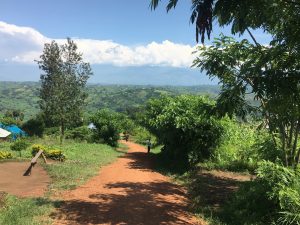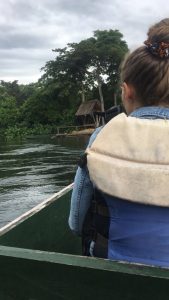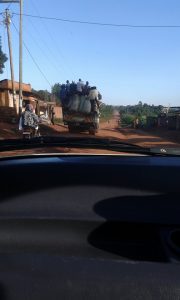By Kirstie Russell
My commute to and from work is, in many ways, the time when I am most reflective on my new life in Kampala. Part of me wonders if this is because it makes up about 2 to 3 hours of my day, but another part of me thinks it is because it gives me time to slow down and really observe the city, its people and the way of life here. Kampala’s exuberance and vibrancy is difficult to put into words. Whatever I write here in this blog cannot possibly do it justice.
I arrived in Uganda nearly two months ago and still, almost every day, I see a passenger riding a boda (the motorcycles that most locals use to get around) while balancing some kind of large object on the end of the bike. For example, last week we saw a passenger transporting what must have been a 4-foot sheet of glass, which if you are at all familiar with Kampala’s traffic, is extremely risky business. The week before that, we saw a boda driver carrying a passenger who was balancing another broken down boda perpendicularly in his hands, clearly on the way to a mechanic. Just yesterday we saw a boda driver transporting what must have been 8-foot tall stalks of sugar cane horizontally through the narrow streets of Old Kampala, just missing other drivers passing by. Each and everyday we see bodas carrying entire families (sometimes up to 3 or 4 people, including small children) to their workplace and to school. Most of the time these small motorcycles narrowly squeeze in between the traffic, which operates relatively seamlessly but on its own accord given that there are barely any stop signs, traffic lights or street lamps. Meanwhile, pedestrians boldly skirt between the vehicles, which move in sudden spurts taking little mercy on anyone who risks getting in the way. Goats and chickens also occupy the roadway, trying to feed on whatever they can find in the grassy patches next to the uneven tarmac ridden with potholes.

In a way Kampala traffic is utterly hectic and completely overwhelming but from another perspective, it’s quite beautiful. The streets are chock-full of multicolored cars, mostly models from the 1980s to early 2000s, and motorcycles weaving in and out carrying all kinds of people wearing anything from a suit to flip flops to a beautifully patterned kitenge dress. All of this takes place against a backdrop of lush green hills, dotted with red roofs and rich rust-coloured dirt. A friend of mine local to Kampala describes the city as “beautiful chaos” and I think that puts its perfectly.
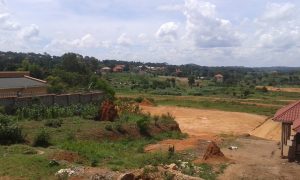
The smells of Kampala are almost as diverse as the users of the roadway. On a warm sunny day, the air is usually thick and polluted but as you pick up speed you get enough of a breeze to catch the smell of fresh cassava cooking in oil in silver pots set up all along the road. Towards the middle of the day, the “rolex guys” start setting up their small stands typically protected by nothing other than a meager umbrella that is nowhere near big enough to stop them from getting drenched by one of Kampala’s intense but brief rain storms. Rolex’s are a classic Ugandan food consisting of a thin omelet rolled up in chapati, which is a wheat based fried bread, similar in a way to naan. Even later in the evening you can see women and their children setting up stoves along the roadside where they spend the evening roasting maize, which they then try and sell to tired and impatient drivers stuck in traffic (which the locals call “jam”). I’ve learned that food is extremely important to Ugandans. In fact, I find that it is one of the very first topics strangers ask me about when they find out I am visiting from Canada: “…but have you tried Ugandan food?” I’ve even had Uber drivers invite me over for dinner out of fear that the local food I have tasted is not up to standard. I have been lucky, though, because the organization where I interned at the beginning of the summer kindly provided its staff with lunch. Lunch typically consisted of a number of staple Ugandan foods, including: ground nut “g-nut” paste, which is a purple paste that is made out of nuts that taste similar to peanuts; mataoke (the most cherished Ugandan food), which is boiled and mashed green banana cooked in a banana leaf; Irish potato, which is similar to boiled potatoes at home; pumpkin, which is similar to acorn squash in Canada; beans or cow peas; rice; and some kind of stew, typically made with chicken, beef or fish.
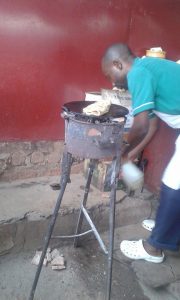
For the first week, I tried every single food available at lunch (with the exception of the meat dishes because I am a vegetarian). I enjoyed most of the dishes but I quickly learned that my body was not used to consuming that much starch all at once in a single meal. Perhaps my challenge with digesting rice, potatoes, chapati, etc. all in one sitting is related to the fact that in North America there is an obsession with body image and because of this, often pressure to eat fewer carbohydrates. It’s possible that given my diet at home, I have difficulty digesting such a large amount of gluten all at one time. In the following weeks, I realized that I had to adjust my lunchtime eating habits to include just beans, cowpeas, rice and avocado in order to avoid getting a stomachache. This disconcerted my colleagues a lot. Every day someone would comment that I wasn’t eating “real” food. Ugandan’s love meat so it was difficult for them to understand why I would choose to eliminate this cherished food group from my diet. Initially, I felt really guilty about not eating all of the different foods offered in the buffet because I could tell that my colleagues were proud of their cuisine and eager to share it with me. I also recognized that choosing not to eat meat is a privilege that is not available to everyone. I didn’t want to come across like a picky eater because let’s be honest, nobody likes a picky eater. I tried to explain to my colleagues that in Canada, unlike Uganda, animals tend not to be raised ethically. Upon hearing this explanation, most of my colleagues understood my reasons for being vegetarian. Many of them seemed aware that food in North America is highly processed and they are very much proud of the fact that Ugandans eat real, natural food. And they should be proud. The tomatoes here are a deep cherry red like I’ve never seen before; the avocados, which are literally the size of my face, are a bright shade of green; and the chickens and goats roam around freely until maturation. The freshness and diversity of the food here is truly amazing, so it is unsurprising that it is such a critical aspect of Ugandan identity.
However, after three weeks of receiving commentary on my food intake, I admittedly became a bit tired out by other people’s focus on my personal dietary choices. Sometimes it felt like it’s all anyone wanted to talk to me about. That and the fact that I had a driver, which I admit, is not something that I felt great about either. While I would have preferred to take public transport to work, I was told by my friend who is from Kampala and who knows the city well that the safest and most reliable way for me to commute to my workplace (which is located about 40-60 minutes outside of the city) was to organize a scheduled driver. Before arriving in Uganda, I had many reservations about this set up. I recognized that this was not a typical form of transport and that it would likely be perceived as “privileged” (as it should be). I wasn’t wrong about this. On my very first day, I was asked the normal question of “where do you live?” and then “how do you reach?” which means “how do you commute?” When I explained that I had a driver due to the challenge of using public means from where I live, the next question was almost always “how much do you pay for that?”
In Canada we tend to avoid asking strangers personal questions, especially questions related to money. However, that doesn’t appear to be the case in Uganda, which is a much more collectivist society than North America, where we are typically more private and individualist. In my experience, Ugandans are much more willing to ask questions about money, family and even in some cases sexuality. Indeed, many people, including work mates, seem to have little reservation asking for intimate details about your personal relationships. A common question people would ask me is why I haven’t had children yet given that I have been with my partner for so many years. At first, my immediate internal reaction to these sorts of questions is shock and then, admittedly, some amount of irritation – why is that anyone’s business other than mine? My external reaction, however, is typically to laugh sheepishly and to try and explain how expectations surrounding family planning are different at home. As a “western intern” in Africa I regularly find myself in this confusing position of feeling like an outsider – distanced and alone – while at the same time feeling like I have no personal space whatsoever because my understanding of what is “personal” is so different from that of most Ugandans, who have a genuine curiosity and well-intentioned concern for one another’s personal wellbeing and family life. I wonder if this is a feeling that international human rights workers feel all of the time or if it something that they get used to as time goes on.
I tried to remind myself of these cultural differences each time I was asked about the cost of my driver. I would try and vaguely explain that while the transportation to and from work is a significant cost, a local friend suggested that having a driver was the safest and most reliable mode of transportation for me, given where I lived. Unfortunately, living close to work was not really an option because the office is so far outside of Kampala and there is limited rental housing in the area. Those who found out how much I paid my driver were shocked by the amount (and to be completely honest when I said the amount out loud, I was too). However, many of them tried to hide their surprise by acknowledging that where I lived was particularly challenging to commute from. Others responded by referring to me sardonically as “their rich friend” or their “rich sister.” These comments were uncomfortable, but I had to learn to brush them off and not take them personally. I anticipated this response and to be quite honest, I understood it. I wished that I felt more confident navigating the matutu routes (local taxi buses) and taking bodas into the rural suburbs outside Kampala, but I knew I had to recognize my own boundaries and I chose to prioritize my safety. I had to accept the consequences of that decision and make the best of it. And funnily enough, it worked out. While at first having a driver seemed like something that was going to make me feel like a total outsider (and a privileged one at that), it had the paradoxical effect of bringing me closer to my colleagues because I could pick several of them up on the way to work and drop them off at the end of the day. In a weird way my commute, which I thought might distance me from my co-workers, actually brought us closer together by allowing us the opportunity to learn about one another’s lives outside of the office.
These very brief interactions in Kampala have taught me the importance of slowing down and noticing the small moments, for example the commute to work and lunchtime conversations, which can be easily taken for granted during an internship abroad. Often times, these seemingly insignificant features of everyday life are the things that we learn from the most. My more challenging moments have also served as an important reminder that when things feel difficult, frustrating or uncomfortable, it is important to remain calm and open-minded because things are not always as they seem and, in some cases, if you just hang in there, they even have a funny way of working out for the best. While it is important to prioritize your wellbeing and know your personal boundaries, I’ve learned that letting your guard down (in some situations) has the potential to change your experience for the better.
